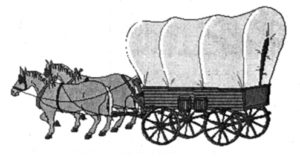 The Oregon Trail was not just a road; it was a decades-long event that brought an influx of pioneers into what became known as “Oregon Territory.”
The Oregon Trail was not just a road; it was a decades-long event that brought an influx of pioneers into what became known as “Oregon Territory.”
Beginning in 1840 with the small group of raggedy mountain men who accompanied Joe Meek and Robert “Doc” Newell, the first wagon crossed the mountains and reached Oregon Territory. Well, the first wagon wheels… they had to throw the bed of the wagon aside as they fought their way through sagebrush, over mountain passes, through forests and high desert plains.
Meek and Newell were not the first to arrive at the fine lands of Oregon. The missionaries had preceded them in the 1830s, and the fur traders had set up posts in the region since 1811.
But who preceded them?
Little homage is paid to the people who were already living here, and had been for well over 10,000 years. The Indigenous folks, the River People, the collective tribes and bands of native peoples of Ni’ chi-wana, the Big River, had their homes here already.
They saw the stream of explorers and pioneers first as a curiosity, then a source of trade, but eventually recognized in horror what was really happening. It was an invasion. By the time they recognized that fact, the damage was well underway, as their people were decimated by disease and the flood of people setting up towns on the lands they once roamed freely.
The year 2018 marks the 175th anniversary of the Oregon Trail, commemorating it from the year 1843 which saw the first big emigration.
But as we celebrate the stalwart spirit of those pioneers who braved hardship to carve a new life for themselves and their families, let’s also commemorate the regional Indigenous people whose ancestors did the same thing over 10,000 years ago, and who have been and are survivors in the face of multiple adversities – not the least of which is the settlement of this noble territory by Euro-Americans and their descendants.
]]>
 We have the opportunity to recognize in the moment that we are living in historic times. If you think about it, not every day brings that gift.
We have the opportunity to recognize in the moment that we are living in historic times. If you think about it, not every day brings that gift.
One of the special things that lands us in the midst of historic times is the 2017 Total Solar Eclipse that is taking place across the USA on August 21. In Oregon we are primed to be in the path of the totality.
Travel to the John Day Fossil Bed area if you want a spectacular view. No one can predict ahead of time what the weather will be like, but chances are far higher in eastern Oregon for cloudless skies than on the Oregon Coast.
Want to camp out? Camp sites are not yet all gone. Click here to see the available self-contained camping right in the center of the John Day Fossil Bed.
]]>Spring is sprung, and with it the biting cold days of winter 2016-17 turn into memories. Was it an historic winter? Some say so, due to the number of days snow covered the landscape, beginning early last December. (You’ll still find snow on a few of the deep recesses in the the north-facing slopes of Highway 30.)
Heavy snowfall is followed, eventually, by snow melt. The Columbia River drains the north-western half of the continent, and all of those mountain passes are feeding streams which feed into the Columbia. Floods in this part of the river have always been a part of our town’s history, and historically they come with spring and early summer weather when the snow pack in the mountains turns into more water than one river can hold.
]]>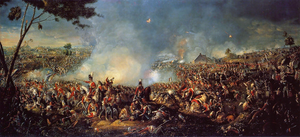
Viva la revolución!
In various languages and cultures, that has been the battle cry over the ages.
Revolutions don’t take place when the populace is well fed, well cared-for, and content. They take place when people feel disenfranchised, shut-out, discontent.
The political season of 2016 may well go down in history books, but lest you think it was unique, review your history tomes.
In the beginning, the central point of American Revolution wasn’t about freedom. Sorry. The British government levied large taxes on the American colonies to help pay for the war debt from the French and Indian wars. The colonists resisted paying the new taxes, via the Sugar Act, the Stamp Act. These acts of “taxation without representation” brought discontent, and the desire to break the shackles of British taxation gave rise to an overthrow of the ruling government.
The Napoleonic wars were caused by a continuation of the French Revolution, the bankruptcy of France as a nation under the monarchy, and the overthrow of the French aristocracy and royal family.
The War of 1812 was a series of economic sanctions taken by the British and French against the US as part of the Napoleonic Wars and American outrage at the British practice of forced recruitment.
The Civil War – if you think the political season of 2016 was horrific, imagine what it was like to go through the lead-up to the Civil War. Political ideals split families like a meat cleaver. The core issue leading up to the Civil War was, again, economics. Would the South be free to pick up their marbles and retreat to their own turf, and operate financially (with big, financially booming cotton plantations) as an independent country? Or would they be overruled, and forced into compliance.
If you look at virtually every war, the central issue revolves around money, and power. The moral and emotional issues become rallying cries to recruit loyalty from the masses. But make no mistake – nations go to battle in a quest for money. And power.
Revolution takes place when the status quo becomes complacent, and willfully ignorant, of the comfort of the masses. It would be lovely to imagine that world leaders would wake up one morning and think, “I believe I shall make a positive change in the world to benefit all people.”
If you depend on world leaders to think along those lines, you may be disappointed.
We can’t control what world leaders – or any other people – think or do. But we can control what WE think and do. Start a revolution in your own life. Make your time count. Identify a positive change and jump into action.
Viva la revolución!
]]>

We have just experienced “Snowpocolypse 2016.” It snowed from noon to 10 p.m., depositing an amazing 8 inches of the white stuff at our front door. Our neighbors 80+ miles to the west in “P-Town” (read: Portland), found their metro area “shut down” for hours as they struggled with 2 inches of slick ice and snow.
Is this common? Historically speaking, no. What WAS “common” was to have the river freeze over and shut down river traffic completely for months. We have a memory of our own grandfather who recalled taking a horse across the Columbia River on ice, sans bridge or ferry.
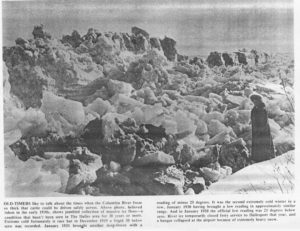
In perusing history, we found a reference to the 1862 coldest temperature recorded in The Dalles, of -24 degrees. The little chill from the current +22 degrees today is a trifling in comparison.
Ben Snipes, the Pacific Northwest Cattle King, lost 90% of his herd during the winter of 1861. Estimates of his cattle holdings in the fall of that year were between 25,000 to 40,000 head of cattle. But in 1861, better than a foot of snow fell during the early part of that winter, to be followed by rain, which in turn was succeeded by intense cold, to be followed by a second two feet of snow followed by rain drizzles. By the closing days of December there was an ice-cap of this character about three feet in depth. By the time Chinook winds came in February, about 10 percent of the cattle remained alive. Gullies were deep with decaying carcasses, where the cattle, seeking each other’s warmth and companionship in their suffering, died together when the Chinook failed to come soon enough.
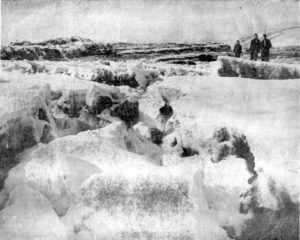
The Dalles’ leading politician and business entrepreneur, Victor Trevitt, died of consumption in San Francisco on January 23, 1883. Trevitt had asked to be buried on Memaloose Island, which was the traditional burial site for the area’s Native people. The problem was the river was frozen at the time of his death. His funeral was delayed due to temperatures of -20 degrees. Access to the island was closed at the time with ice, and heavy snow had fallen; so Trevitt’s body was placed in a snow bank until the river should open and steamboat traffic be resumed. His funeral was finally held on March 10, 1883. He had a Masonic funeral. Trevitt was the only white man to be buried on Memaloose Island. He said, “I have but one desire after I die, to be laid away on Memaloose Island with the Indians. They are more honest than whites and live up to the light they have. In the resurrection I will take my chances with the Indians. I won’t have any chance to get into heaven unless I slip in with the Indians. When Gabriel blows his horn on the last day, I will get up with the Indians, wrap my blanket about me and slip in with them and St. Peter will never notice me.”
These recollections will hopefully bolster your courage as you head out the door to shovel the mere eight inches from the “2016 Snowpocolypse.”
]]>One does not spring into existence fully informed about much of anything, except how to eat, sleep, and cry. Acquiring skills and knowledge takes time and a little experimentation.
When the History Queen began this website, many years, it was from a heartfelt desire to make local history more accessible to the masses, more readily understood, to help inform people as to how we got to where we stand today.
Bit by bit, the learning came – how to jiggle webstuff about and make it behave, and how to identify the layers upon layers of historical circumstance that shaped and directed the actions of our forebearers.
Upon reviewing the stuff of history that was first used in the crafting of this website, it has become apparent that it was long overdue for a refresher. Some things pertaining to modern day venues needed updates; some factoids about history needed clarification or correction.
But most importantly, making this a website useful to researchers, teachers, local residents as well as traveling enthusiasts is the priority. There is so much to share about this area in the “Old West.” I hope you enjoy the journey we are on.
]]> The Sanborn maps of The Dalles, Oregon (in Wasco County) are back online. It’s been one of the main research tools that my gentle readers have missed the most during this website’s recent “senior moment” of confusion and forgetting where to find pages.
The Sanborn maps of The Dalles, Oregon (in Wasco County) are back online. It’s been one of the main research tools that my gentle readers have missed the most during this website’s recent “senior moment” of confusion and forgetting where to find pages.
You’ll find them under the “History” tab, at http://historicthedalles.org/history/sanborn-maps/
The maps are focused on The Dalles’ downtown Historic Commercial District, and range from the years 1884 to 1960. (I love the fact that the early maps list the brothels as “female boarding.”
A website update like this may not look like much, but it takes a bit of time to string together this many links and as remote as the concept might be of the History Queen making an error, it is possible. Let me know if you find anything amiss at [email protected].
]]>There is an old adage: “The more things change, the more they stay the same.”
It has been a tumultuous political season, and in a more robust, fervent, and brazen way than many of us remember. Ever.
Yet if one takes a look through the history books, one sees similar episodes in national and world history that bear striking similarities. Can one imagine the tone the politics took during the Civil War? We still bear the after effects, don’t we? The Revolutionary War. The Napoleonic War. Any time conflict has been on the national radar, people have taken sides, taken arms, taken offense. It’s the same story, clothed in more modern style.
One can take heart that the people in our communities retain the same human faces, the same neighborly countenance. Reaching out to strengthen the bonds in our own neighborhoods is the best way to weather political storms. Regardless of the changing political winds, our communities will stay right here. And that brings some comfort.
]]>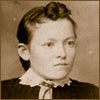 They had it easy, those Oregon Trail pioneers. They didn’t have to deal with WordPress, Facebook, Twitter or anything on the internet. Maybe a little dysentery, a little cholera – but not a virus that would wipe out an entire hard drive!
They had it easy, those Oregon Trail pioneers. They didn’t have to deal with WordPress, Facebook, Twitter or anything on the internet. Maybe a little dysentery, a little cholera – but not a virus that would wipe out an entire hard drive!
Maybe if they’d had the chance to play the Oregon Trail game on their computers, they would have decided to stay put and forgo the arduous trek to the West.
But being made of stern stock, the History Queen shall carry on. Eventually this website shall be wrestled under control.
]]>Welcome to Historic The Dalles. In case you hadn’t noticed, this site is undergoing major reconstruction. It’s long overdue and thus there shall be dust and debris flying around for a few days. Check back in regularly and hopefully you will see progress. I vow to have it all tidy and up to date by the end of 2016.
]]>